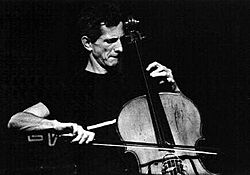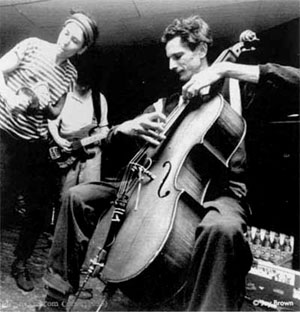Tom Cora facts for kids
Quick facts for kids
Tom Cora
|
|
|---|---|

Cora at the Moers Jazz Festival, 1997
|
|
| Background information | |
| Birth name | Thomas Henry Corra |
| Born | September 14, 1953 Yancey Mills, Virginia, U.S. |
| Died | April 9, 1998 (aged 44) Draguignan, France |
| Genres | Jazz, avant-rock, experimental, free improvisation |
| Occupation(s) | Musician, composer |
| Instruments | Cello |
| Years active | 1979–1998 |
| Labels | No Man's Land, Sound Aspects |
Thomas Henry Corra (born September 14, 1953 – died April 9, 1998), known as Tom Cora, was an American cellist and composer. He was famous for his unique way of playing the cello in experimental jazz and rock music. Tom Cora often used improvisation, which means making up music on the spot. He played with many famous musicians like John Zorn and was part of bands such as Curlew, Third Person, and Skeleton Crew.
Contents
Tom Cora's Early Life and Music Journey
Tom Cora was born in Yancey Mills, Virginia, USA. When he was young, he first played the drums on a local TV show. In the mid-1970s, he played guitar in a jazz club's house band in Washington, D.C. He started playing the cello while studying at the University of Virginia. He learned from talented cello teachers, including one who studied with the famous cellist Pablo Casals. During this time, he also started his own group called the Moose Skowron Tuned Metal Ensemble. He even built some of the instruments for this group himself!
Moving to New York and New Collaborations
In 1979, Tom Cora moved to New York City. There, he worked with guitarist Eugene Chadbourne and introduced the cello to different music scenes. He played in many clubs with other improvising musicians like John Zorn and Fred Frith.
Tom Cora also teamed up with George Cartwright and Bill Laswell. This led to them forming an art rock band called Curlew in 1979. Tom Cora played with Curlew for over ten years and appeared on five of their albums.
Skeleton Crew: A Two-Person Band
In 1982, Tom Cora and Fred Frith created a band called Skeleton Crew. This was an rock and jazz band known for their live shows. What made them special was that Tom and Fred often played many instruments at the same time! They were like one-man bands on stage. For their performances, Tom Cora even built special musical devices he could play with his feet.
Skeleton Crew toured a lot in Europe, North America, and Japan for five years. They released two studio albums: Learn to Talk (1984) and The Country of Blinds (1986). Later, Zeena Parkins joined the band.
Third Person and Other Bands
Tom Cora was also a member of a trio called Third Person. This group started in 1990 and played live shows with percussionist Samm Bennett. The "third person" in the band would change for each concert. They released two CDs with recordings from these shows.
Cora played with several other bands too, including Nimal and the post-rock quartet Roof. In 1990, he started playing with a Dutch anarcho-punk band called the Ex. This was a very successful partnership, and Tom Cora played hundreds of concerts with The Ex and appeared on two of their CDs.
In 1995, Tom Cora and Fred Frith worked together again as Skeleton Crew. They created Etymology, which was a CD-ROM filled with sound samples and wire manipulations.
Tom Cora's Passing
Tom Cora passed away at the age of 44 in a hospital in France. He lived there with his wife, singer Catherine Jauniaux, and their son, Elia.
After his death, a special concert was held to help his family. Many musicians, including Catherine Jauniaux and Fred Frith, performed. A CD of this concert, It's a Brand New Day – Live at the Knitting Factory, was released.
John Zorn also put together a two-CD set called Hallelujah, Anyway – Remembering Tom Cora. This set included many of Tom Cora's recordings and new music based on his compositions.
Tom Cora also appeared in a 1990 documentary film about Fred Frith called Step Across the Border. The film showed Tom and Fred rehearsing in New York City.
Tom Cora's Solo Work
Besides playing with bands, Tom Cora also started performing solo concerts in 1986. Playing a whole concert by himself was a big challenge, but he learned to make it work. He performed solo shows across North America, Europe, and Japan. Two live albums from these performances were released in 1987 and 1991.
While in The Netherlands, Tom Cora spent time at STEIM, a special research center for electronic music. There, he created a unique system for live sampling and triggering sounds using his feet. He showed off this new system during a 25-concert solo tour in 1992. Sadly, this special instrument was later lost on a train while he was touring Switzerland.
Tom Cora also composed music for films and dance performances. He created music for the National Film Board of Canada and for choreographer Donna Uchizono. In 1990, he even won an award for his dance music! He also composed a solo cello score for the silent film Man with the Movie Camera. In 1994, he received a grant to create a score for the same film for a whole group of musicians. This music was performed in North America and Europe in 1996.
Tom Cora's Unique Cello Playing Style
Tom Cora's cello was special. It was often "prepared," meaning he added things to it or changed it to make different sounds. It was also electronically changed and made very loud using an amplifier. He developed a way of playing the cello that sounded like an electric guitar, using strong, rhythmic chords and percussive sounds. He would hit, scrape, and twist his cello to get the sounds he wanted.
Cora explored improvisation that didn't follow traditional rules. He also studied Turkish and Eastern European folk music. You can hear the influence of this folk music in many of his works. For example, his band Skeleton Crew once played only Eastern European folk tunes for an entire concert.
When he was on stage, Tom Cora had a very strong presence. He was known for his intense look and how busy he was, often playing with all four limbs at once. He was a captivating performer.
Discography
Solo
- Live at the Western Front (1987, No Man's Land)
- Gumption in Limbo (1991, Sound Aspects)
Curlew
- Curlew (1981, Landslide)
- North America (1985, Moers)
- Live in Berlin (1988, Cuneiform)
- Bee (1991, Cuneiform)
- A Beautiful Western Saddle (1993, Cuneiform)
Skeleton Crew
- Learn to Talk (1984, Rift)
- The Country of Blinds (1986, Rift)
- Learn to Talk / Country of Blinds (1990, RecRec)
- Etymology (1997, Rarefaction)
- Free Dirt (Live) (2021, Klanggalerie)
The Ex
- Scrabbling at the Lock (1991, RecRec)
- And the Weathermen Shrug Their Shoulders (1993, RecRec)
Roof
- The Untraceable Cigar (1996, Red Note)
- Trace (1999, Red Note)
Third Person
- The Bends (1991, Knitting Factory)
- Lucky Water (1995, Knitting Factory)
With others
- Andrea Centazzo: Environment for Sextet (1979, Ictus)
- Eugene Chadbourne: 2000 Statues and the English Channel (1979, Parachute)
- John Zorn: Archery (1982, Parachute)
- Tom Cora and David Moss: Cargo Cult Revival (1983, Rift)
- Ferdinand Richard: En Avant (1983, RecRec)
- Duck and Cover: Re Records Quarterly Vol.1 No.2 (1985, Recommended)
- Tom Cora and Hans Reichel: Angel Carver: Live in Milwaukee and Chicago (1989, FMP)
- Rene Lussier: Le tresor de la langue (1989, Ambiances Magnétiques)
- Nimal: Voix de Surface (1990, RecRec)
- The Hat Shoes: Differently Desperate (1991, RecRec)
- Tetsuhiro Daiku: Yunta & Jiraba (1993, Disc Akabana)
- Richard Teitelbaum: Cyberband (1994, Moers)
- Kazutoki Umezu: First Deserter (1995, Off Note)
- Fred Frith: Allies (Music for Dance volume 2) (1996, RecRec)
- Butch Morris: Testament: A Conduction Collection (1996, New World)
- Tom Cora and various artists: Hallelujah, Anyway – Remembering Tom Cora (1999, Tzadik)
- Tom Cora, Chris Cutler and Fred Frith: Live in Tel Aviv and Aubervilliers (2021, Fred Records)
- Buga Up (band with Tom Cora, Guigou Chenevier and Chris Cohade): A Quick Morsel of Energy (Live à Vandoeuvre 1987) (2021, Thödol Records)
See also
 In Spanish: Tom Cora para niños
In Spanish: Tom Cora para niños


